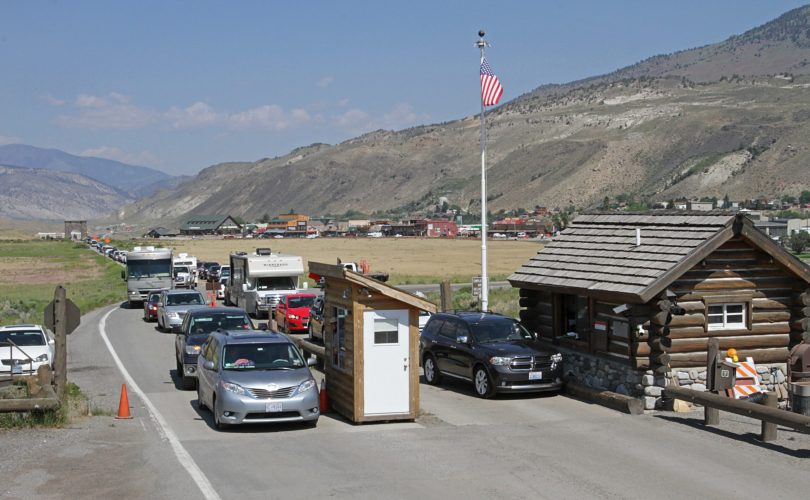Taking your Tom Cruise-infatuated spouse and out-of-town in-laws to Mission Impossible: Final Reckoning would cost about $44, popcorn not included. It would provide three hours of entertainment. Or, for $35, you could take the relatives to Yellowstone National Park on a seven-day pass. Gas, campgrounds and s’mores would cost extra. But still, all the scenery you can handle sets you back just $8.75 per person, per week.
Tate Watkins thinks that bargain pricing leaves Yellowstone Park with an impossible mission. Congress hasn’t appropriated enough funding to keep up with Yellowstone’s estimated $1.5 billion maintenance backlog, let alone the $23 billion in repairs throughout the National Park Service. So Watkins, a fellow at the Property and Environment Research Center, or PERC, argues that an entrance fee increase — particularly one aimed at foreign visitors — would help the park cover its costs without chasing away customers.
President Donald Trump agreed. On July 3, he ordered Secretary of Interior Doug Burgum to increase fees on foreign tourists seeking to enter national parks and federal recreation areas. Money raised by the price increases would go to improve infrastructure or “otherwise enhance enjoyment of or access to” federal parks for American citizens.
The order also calls on the Interior Department to work with the State Department to encourage more international tourism to parks and recreation areas.
Further down, the order tells Burgum to “especially scrutinize all recreational access rules or other restrictions promulgated or enacted during the prior [Biden] administration. And it revokes an Obama memorandum on “Promoting Diversity and Inclusion in our National Parks, National Forests, and other Public Lands and Waters.”
The order was one of two Trump issued just before Independence Day affecting federal public lands. The second creates a Make America Beautiful Again Commission to carry out the “policy of my Administration to prioritize responsible conservation, restore our lands and waters, and protect our Nation’s outdoor heritage for the enjoyment of the American people.” The MABA Commission would be led by the Interior Secretary, joined by the secretaries of Defense, Agriculture, EPA, Office of Management and Budget, Council of Economic Advisors, and numerous other administration officials.
Neither order provides specifics for the costs or revenue involved in their actions. The PERC study offers a glimpse of how the foreign visitor surcharge might work.
“In 2026, NPS will establish a surcharge for foreign visitors that is estimated to generate more than $90 million to keep national parks beautiful.”
Budget Brief, FY 2026, National Park Service
“The Economics of Awe” study released on June 26 by the Bozeman-based think tank estimates that charging foreign visitors $100 apiece to enter Yellowstone would raise about $55 million a year, while only discouraging about 57,000 of the average 660,000 internationals who come to see to America’s first national park. PERC estimates that would cover Yellowstone’s $43 million annual maintenance outlay, with enough left over to get rid of the abandoned Old Faithful wastewater system ($6 million) and rebuild the Midway Geyser Basin ($5 million).
“The spirit of this is: What is the menu of solutions-oriented options that can put Yellowstone on a path of sustainability?” Watkins told Mountain Journal. “We think the potential benefit gained through some of these suggestions we’ve made are compelling enough to think about. Fees are a sound way to do that because of the incentives they create, and the positive feedback loops.”
Trump’s order confirms an Interior Department proposal targeting nonresidents for revenue. A budget brief for NPS released in May states, “In 2026, NPS will establish a surcharge for foreign visitors that is estimated to generate more than $90 million to keep national parks beautiful.” The brief does not provide further details about the surcharge or how it would be spent. Requests for comment from NPS were not returned as of July 4.
More than half that amount would be raised through the $100 foreigner surcharge in Yellowstone Park alone, PERC’s study calculates. However, a 2017 Interior proposal to increase entrance fees at 17 major national parks from $30 to $70 per vehicle was estimated to bring in just $70 million in additional revenue per year. The plan was floated by then-Interior Secretary Ryan Zinke, who is now Montana’s 1st district congressman. It was withdrawn after intense public opposition.
Yellowstone currently collects approximately $14 million each year in entrance fees. The PERC study figures that adding a $5-per-person surcharge to the current $35 entry fee would reduce total Yellowstone visitation by 2.8 percent while raising $19.3 million in new revenue.
PERC assumes that Yellowstone visitation is inelastic because the number of visitors coming each year will not decrease significantly even if the entry price gets more expensive. In economics, something is elastic if it changes in response to outside forces. It is inelastic if it does not change when other factors do.

That free market-based approach rankles other public lands advocates who consider national parks a responsibility of Congress to maintain for the common good. Emily Douce with the National Parks Conservation Association says entry fees should never become a barrier keeping people from experiencing America’s most iconic places.
“Entrance and recreation fees are vital to keeping national parks running, funding everything from trail repairs and education programs to law enforcement and visitor services,” Douce, NPCA’s government affairs deputy vice president, said in an email. “After years of chronic underfunding, our national parks increasingly rely on these fees to enhance the visitor experience. However, they should not replace annual appropriations from Congress.”
In PERC’s analysis, international visitors already spend about $2,500 apiece on a vacation to the United States, and are therefore unlikely to skip a bucket-list national park just because of a high ticket price. Watkins added that the concept of charging varying rates for locals and non-locals is well-established. For example, Nairobi National Parks in Kenya charge locals 860 Kenyan shillings a day, compared to $43 U.S. for international visitors. The park website doesn’t mention that 860 shillings are worth $6.64.
Douce said while NPCA agrees new fee strategies could help address maintenance needs, the concept needs a game plan. “Charging international visitors more is not uncommon globally,” she said, “but any such policy must be designed thoughtfully.”
Watkins acknowledged the actual entrance gate policy hasn’t been worked out yet. But it assumes local residents would be able to claim discounts by showing a driver’s license or similar ID, rather than requiring proof of citizenship from all passengers. Currently, Montanans can pay a $9 state parks fee when they license their vehicles, and enter any state park for free all year. Nonresidents are charged $8 per day.
“Charging international visitors more is not uncommon globally,” she said, “but any such policy must be designed thoughtfully.”
Emily douce, National parks conservation association
Other Greater Yellowstone amenities can be equally expensive. The Grizzly Discovery Center at West Yellowstone charges $16.50 per adult, or $66 for the carload of four. Admission to Jackson Hole’s National Museum of Wildlife Art is $18 per person, or $72 per carload.
And park expenses aren’t getting cheaper. A 2022 spring runoff flood caused an estimated $1 billion in damage around Yellowstone’s North Entrance. The National Park Service received $60 million within days to start repairs to roads and sewer systems in Mammoth, Gardiner and Cooke City. It reimbursed Yellowstone another $16 million in repair expenses in 2025, along with $12 to the U.S. Forest Service for related repair work from the flood.
The Interior Department expects to reduce construction and major maintenance across the National Park Service from $172 million to $99 million in 2026. Spending on recreation and preservation programs would fall from $89 million to about $12 million. Historic preservation programs would decrease from $169 million to $11 million. And general operations budgets would go from $2.9 billion in 2025 to $1.9 billion in 2026.
PERC’s commitment to “free market environmentalism” often gets it accused of advocating for turning national parks into profit-making institutions like Disneyland. Watkins refuted that, saying Yellowstone’s founding concept as a national “pleasuring ground” presumed it would remain accessible to all, not just those able to pay a premium price. But he added that park tourists could also be presumed to share the burden they impose.
“If you visit, you’re adding to wear and tear on pavement,” Watkins said. “The bathroom trash cans have to be empty two to five times a day. The trails are eroding. If you’re visiting the park and adding to that pressure, it’s fitting to pay more and offset the impacts.”










